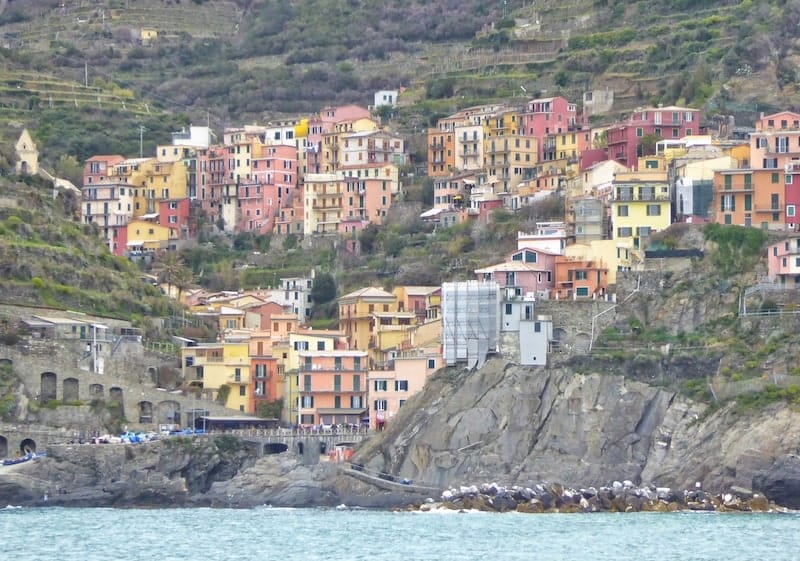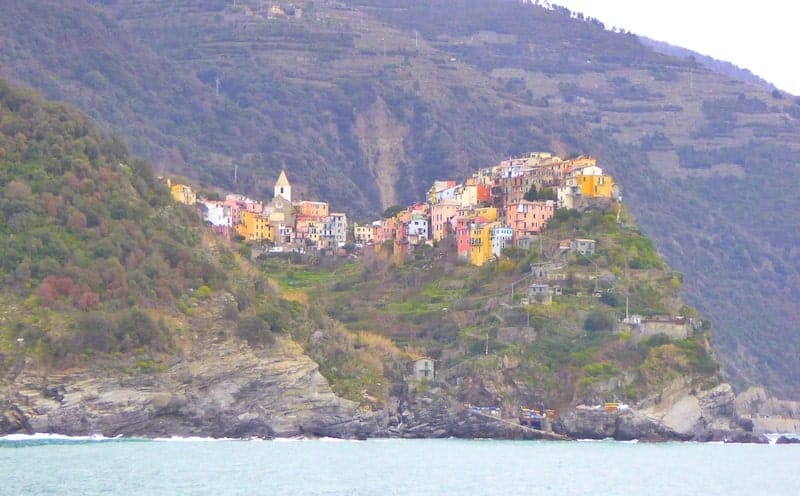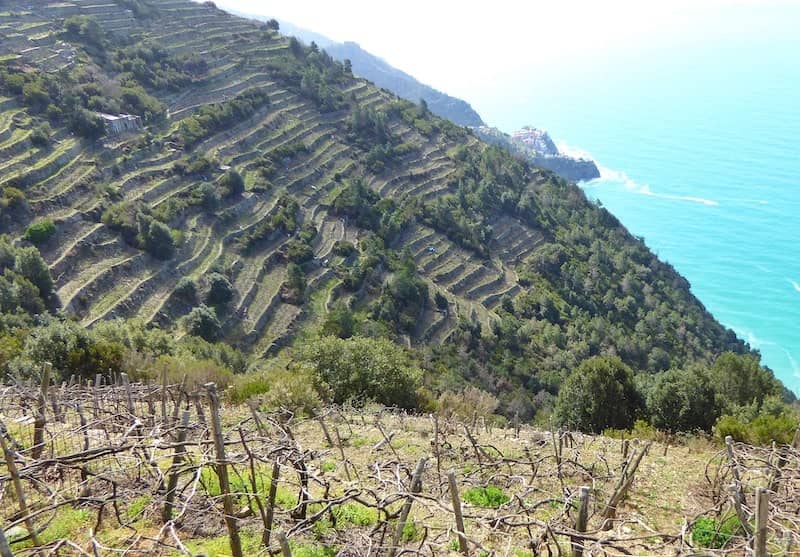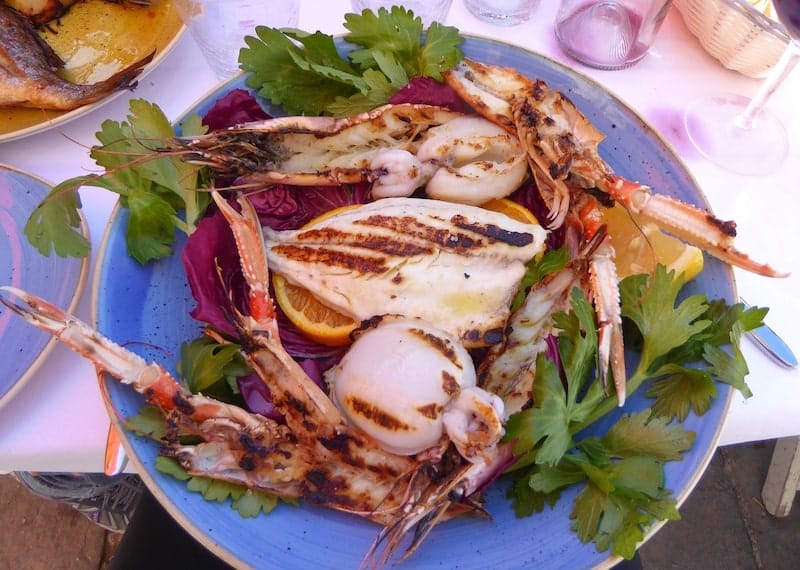Updated August 5, 2023
These 15 tips for visiting Italy’s Cinque Terre are a compilation of answers to the many questions that arose during my pre-trip research and discoveries during our five-night stay. It’s not a definitive guide on Cinque Terre, but it should give you some practical and invaluable tips to help you plan your visit to one of the most beautiful places on the planet.
Table of Contents
- What is the Cinque Terre?
- 15 Tips for visiting Cinque Terre
- 1. Consider flying into Pisa
- 2. Avoid the high season
- 3. Stay at least three nights in Cinque Terre
- 4. Stay in Riomaggiore (but I’m biased)
- 5. Book an apartment with a balcony
- 6. Pack light
- 7. Keep an eye on your valuables
- 8. On at least one day, get a Cinque Terre Card
- 9. Enjoy the view from the water
- 10. Take a hike
- 11. Get up early
- 12. Carry loose change
- 13. Pack a day bag
- 14. Get connected
- 15. Enjoy the food!
- Conclusion
What is the Cinque Terre?
Pronounced ‘Chin-kweh Terra,’ meaning ‘five lands,’ Cinque Terre is an intricately woven web of terraced hillsides, colourful cliff-side villages, and interconnected trails. A land and culture so unique, it’s protected as a national park, and recognized by UNESCO as a place of worldwide importance to cultural and natural heritage.
People come to the Cinque Terre to admire the sweeping vistas and hike the myriad of paths crisscrossing the region. The rich bounty of seafood harvested from the nearby waters, also protected, is another magnet for visitors.
All this, and more, make it a popular tourist destination. Besides the specific suggestions described below, some general tips on visiting Italy will be useful.
15 Tips for visiting Cinque Terre
1. Consider flying into Pisa
Pisa is a handy launching point for reaching the Cinque Terre. Pisa International Airport (PSA) is conveniently located, a few kilometres from the town centre. There’s regular train service from Pisa to Cinque Terre, most with a change in La Spezia. One-way fares in 2023 start at €12.30.

Pisa is ideal if you’re flying with a low-cost airline from another European city. The savings can be substantial. At least, that was my experience with a Ryanair flight from Malta. Given Pisa’s proximity to Cinque Terre (113 kilometres), it’s useful for those with severe time constraints.
If you need overnight accommodation, we were very pleased with the Hotel Terminus and Plaza. It’s a couple of blocks from the train station (Pisa Centrale), and a very pleasant 30-minute walk across the River Arno up to the leaning tower and other amazing Pisa attractions.
2. Avoid the high season
After arriving in the Cinque Terre, my biggest revelation concerned the crowds. We mistakenly visited over Easter, and paid for the oversight. On Easter Sunday, the crowds were insane. This was compounded by the fact that we didn’t take the cruise schedule into consideration. That day, a 2,000-passenger ship docked in the nearby port of La Spezia.
The high season runs from mid-June to mid-September, and includes Easter and school holidays. I’d suggest looking up the dates of national holidays and avoiding those periods as well. A source of intel on visiting cruise passengers is the La Spezia Cruise Ship Schedule.
In early April (March 30 to April 4), we experienced spring rains that closed trails, swells that kept the ferries at bay, and it was too cold for swimming. Although, when we were able to hike, it was very pleasant, and hiking among spring-blooming flowers was a bonus. Plus, it beat the summer heat, which I understand can be brutal.
I’d choose early May, or late September. An advantage of September is that the sea remains warm enough to swim, and grapevines are covered with leaves and fruit. It’s also harvest time, presenting an opportunity to observe the backbreaking work involved in getting the grapes to the drying racks or the wine cellars.
3. Stay at least three nights in Cinque Terre
I think it’s worth it to stay in one of the five villages. They’re close together, with a train journey of 3 or 4 minutes between each one. Choose one, and move from village to village by train, shuttle bus, boat, or hiking trail.
An advantage of staying in Cinque Terre, as opposed to a neighbouring town, is the ease associated with getting up early. It’s a great time to enjoy the tranquillity of Cinque Terre before the onslaught of tourists arrives for the day.
Most visitors and tour groups are day-trippers. These include Italian families, and tourists from cruise ships and day tours from Pisa and Florence. During the high season, picture crushing crowds on trains and congested main thoroughfares between 10:00 and 16:00.
I enjoyed soaking up the old-world charm of these once-remote villages. My advice is to get lost in narrow-stepped alleyways and interior passages, away from the congested tourist areas. Observe children making the most of limited space to kick a ball or ride bikes. Marvel at how residents raise chickens or grow vegetables in such small plots of land. Admire the resilience of dry stone walls that have supported the construction of buildings and gardens for centuries. Stroll past houses with chipped paint facades, and laundry fluttering in the breeze.
Cinque Terre is the type of place that rewards those who enjoy a slower pace of travel. We stayed five nights, which was perfect.
4. Stay in Riomaggiore (but I’m biased)
Each village has its own personality, and any one would be a good choice: Monterosso al Mare, Vernazza, Corniglia, Manarola, or Riomaggiore.
I’m partial to Riomaggiore, with its colourful tower houses filling the steep ravine all the way down to its quaint harbour. It has easy access to the station, connected to the main street (Via Colombo) by a pedestrian tunnel. There are several interesting walks within the village, a pebbly beach, and convenient shuttle bus service from the town centre. It’s well positioned to hike the coastal trail. The section from Riomaggiore reopened in July 2023 after being closed since 2012.
Unfortunately, I can’t comment on Manarola. We succumbed to the Easter Sunday crowds and escaped to the solitude of our apartment. When the ferries were up and running, Manarola wasn’t accessible by boat.
We ruled out staying in Corniglia, given its cliff-top location at 182 metres above sea level. It’s not close to the station, and involves a zigzagged climb of 382 steps.
However, these realities translate into less tourist traffic. It could be a good choice outside the busy tourist season when the shuttle from the station and neighbouring towns is less crowded. Its small, intimate main square is an inviting space to enjoy lunch, and its tranquil alleyways lead to a broad terrace with panoramic views of the Ligurian coast and adjacent villages.
Some say Vernazza is the most picturesque. This is something, because the floods and landslides of 2011 had a devastating impact. Look for the large mural near the train station.
Its recovery has been nothing short of remarkable. Ironically, Vernazza is well positioned for hiking the coastal trail. Both sections, to the north and south, are open (weather permitting).
Monterosso is more spread out with two distinct areas, and a resort-like atmosphere in the newer section. It has a sandy beach and boasts more nightlife than the other villages.
It should be acknowledged that staying in a nearby town might be a better fit for some travellers. There’s a plethora of accommodation options, and it tends to be cheaper. It could be a good choice if you’re on a tight budget, can’t find decent accommodation in one of the five villages, or travelling by car.
Regular train service puts the five villages within easy reach of neighbouring towns. It takes 7 minutes to travel between La Spezia and Riomaggiore, and 5 minutes from Levanto to Monterosso.
Also, nearby towns have lots to offer. For example, Portovenere is often referred to as Cinque Terre’s sixth village. Some say it’s more charming than the five villages combined. It has a picturesque harbour bordered by a seaside promenade flanked by pastel-coloured buildings similar to those in the Cinque Terre. It’s much less crowded, and there are ferry connections to the five villages.
5. Book an apartment with a balcony
If you can find an apartment with a balcony, and it covers all your other needs, book it, as far in advance as possible. At the time of our booking (December, for April), VRBO (Vacation Rentals by Owner/HomeAway) had way more listings than Airbnb.
We stayed at “Romantic apartment with a breathtaking view — and a garage” (VRBO Listing #6120099) for a total of €762 for five nights. This worked out at €50 per person per night when split between three friends.
An apartment gives you the option to eat in. One with a balcony allows you to enjoy a leisurely drink at the end of an active day, while soaking up the pastel glow of Cinque Terre’s famous sunsets.
Riomaggiore’s retail outlets are conveniently located along Via Colombo, close to the entrance to the pedestrian tunnel. We were regular customers of a shop selling fresh pasta, sauces, and pesto. Grocery stores were well stocked, and sold beer and wine at reasonable prices. Other villages offered similar amenities.
6. Pack light
Large bags are a liability. Unless you’re able to coordinate a luggage pickup, storage, and delivery service, you’ll have to lug your bags from the station to your accommodation. Chances are the route will involve steps of all shapes and sizes with and without railings… narrow, wide, winding, steep… and lots of them.
If your visit is part of an extended trip, consider packing a small bag for the Cinque Terre portion.
If you have lots of luggage or mobility issues, staying in Monterosso might be a better choice. It’s the only one of the five villages built on relatively flat land.
7. Keep an eye on your valuables
Pickpocketing is common in parts of Italy, especially in areas bustling with tourists. Beautiful sights, crowds, and busy train stations are favourite hunting grounds of pickpockets. Signs throughout the Cinque Terre remind visitors to be aware at all times.
8. On at least one day, get a Cinque Terre Card
There are two versions of the Cinque Terre Card. The only difference is that one includes unlimited train travel.
The Cinque Terre Card (‘treno’/train version) offers unlimited train travel between Levanto and La Spezia, and the five villages in between. It includes the use of ATC buses connecting nearby villages, access to all trails, Wi-Fi at park hotspots, and free use of public toilets. It can be purchased at every Cinque Terre station. A one-day card costs €18.20 (adults, 12 to 69 years) in 2023 but there are other pricing options.
The Cinque Terre Card (‘trekking,’ without train travel) costs €7.50.
We bought the card on the day we planned to visit each village by train. Our best estimate was that we’d likely take six train rides. As each trip between two villages costs €5, train travel alone would have amounted to €30 per person. Another consideration was the convenience of not having to stand in line at a ticket counter, or carry the right change for a machine.
9. Enjoy the view from the water
On our fourth and final day, the sea was calm enough for ferries to dock in three of the four villages with direct access to the sea. (Corniglia doesn’t have water access.) There are several pricing options. We chose the one-day-hop-on-hop-off pass for travel between Riomaggiore to Monterosso and points in between.
Ferries operate on an hourly schedule. Pick up a printed timetable with your ticket, and make a note of the last trip of the day. Listen for announcements on any changes to the schedule. Also, keep your ears tuned to the beautiful rhythmic pronunciation of each of the five villages: ‘Riomagggeeoray,’ ‘Manarolllah,’ ‘Corneeelya,’ ‘Vernaaatsah,’ and ‘Monterrohhhso.’
Tickets can be purchased online but this isn’t recommended as the service can be suspended at any time for reasons related to the weather. Instead, purchase a ticket at a booth or table near where the ferry docks in each village.
The view from the sea revealed aspects and features that could only be seen and appreciated from a distance. The two parts of Riomaggiore, the station and village centre, were accentuated with the main road (SP370) high above in the background.
Manarola might be the most photographed village, with its cluster of pastel coloured houses clinging to the hillsides like a multi-coloured crab. The terraced vineyards above Manarola produce sciacchetrà, a sweet late-harvest dessert wine.
The Church of San Pietro dominates the skyline of Corniglia, perched securely on a cliff top overlooking the sea. The smallest of the five villages, the colourful houses resemble a closely-knit collection of toy building blocks.
10. Take a hike
The Sentiero Azzurro (Blue Trail) is the coastal walk consisting of four sections. For centuries, it was the only road connecting the five villages. In July 2023, part of the popular section known as Via dell’Amore (The Way of Love) starting in Riomaggiore reopened under strict conditions.
Each morning, we dropped into the tourist office to check on the status of the coastal trail. One section, between Vernazza and Monterroso had finally opened after the rains, but we chose to hike another path crossing the terraced slopes high above Manarola and Corniglia.
Hiking in the right direction can make a world of difference in terms of views and level of difficulty. Talk to the folks at the tourist offices, and confirm the information with travellers who have actually hiked it.
For example, we took the ATC shuttle bus from Riomaggiore to Volastra, to hike from Volastra to Corniglia. (In 2018, tickets were €2.50 from the tourist office or €5.00 from the driver). In the direction from Volastra, it’s a relaxing downhill hike through terraced vineyards, forests, and olive groves. The views are spectacular. We encountered people coming in the opposite direction from Corniglia who were struggling with the uphill climbs. For a description and tips, see Hike through vineyards high above Manarola and Corniglia in Italy’s Cinque Terre.
A very useful map of the main trails, with their respective route numbers, can be downloaded in advance.

Take your time on the trails. Most of them are old donkey paths, with sections where it’s necessary to form a single file. Most don’t have any guardrails, and the uneven terrain is littered with boulders and loose gravel. Pause frequently to soak up the views and take photographs.
11. Get up early
The day-trippers arrive mid-morning, and by dusk, the vast majority are gone. Head out early to observe workers in the town centre removing trash, delivering supplies, or stocking stores and restaurants. They’re small family-run businesses, with not a single McDonald’s, Burger King, Walmart, or brand name in sight. There are severe restrictions on building permits and corporate development in the park, and for the most part, vehicles are restricted to the entrances of each village.
Even at 08:00, there are very few people out and about. It’s a wonderful time to take photographs.
It’s also a good time to hit the trains and trails, and avoid the warmer temperatures of later in the day.
12. Carry loose change
Support the buskers and carry coins to drop in their boxes. We encountered a flute and saxophone ensemble in the Riomaggiore tunnel, and accordion players in Corniglia and Monterosso.
13. Pack a day bag
You’ll need sturdy footwear providing good traction on narrow, slippery, steep, uneven trails with patches of loose gravel.
Staying hydrated is critical, especially on the trails. Keep your water bottle topped up. There are fountains in each village.
Carry a packable rain jacket, layers for warmth or protection from the sun, a swimsuit, packable sun hat, sunblock, and snacks on the longer routes.
14. Get connected
I’m a huge fan of being connected to a cellular network while travelling. It offers convenience and security, and the ability to look things up while on the move.
Maybe you can relate. I feel more organized if I can call a local accommodation host, pinpoint the exact location of our accommodation, check bus and train schedules, and follow my progress on a digital map. There are several Cinque Terre apps, with the most useful being ‘Parco Nazionale delle Cinque Terre‘ with its hiking guide.
Mobile plans within Italy are affordable. Or, perhaps a roaming plan with your home-based provider is a better fit for your circumstances. Despite my misadventure with Vodafone, buying a SIM card in Italy is my first choice for getting connected with a physical SIM card.
15. Enjoy the food!
Hop into any restaurant where the menu, the view (or both) catches your eye. What makes Cinque Terre special is the seafood and locally sourced fresh produce. Another is enjoying food with a view.
Grab a table on a terrace hugging a cliff, or seaside where the waves almost lap against your chair. Try some of the region’s specialities such as trofie pasta with basil pesto, or sciacchetrà wine with biscotti. Liguria is where foccaccia was born, and the region is famous for the abundant array of fresh seafood from nearby waters. Or, grab a regional speciality while on the move. “Fritti misti” consists of small bites from the day’s catch, battered and fried and served in a paper cone topped with a lemon wedge.
Intersperse food stops with an Aperol Spritz, limoncino, or gelato.
There’s something for everyone. For example, at the family-run Taverna del Capitano on the seaside piazza in Vernazza, one of my friends chose grilled whole sea bass. Another had pistachio-crusted lamb, and I chose grilled seafood with a hint of lemon and oil. It oozed in both flavour and freshness.
With easy access to well-stocked grocery stores, consider packing a picnic of bread, cheese, prosciutto, olives, fruit, and wine. Check out bakeries offering focaccia, farinata, arancini, paniccia, pizza, and ready-to-go pasta. Leave the crowds behind and head for the hills, and a picnic spot with a view.
You’re never far from good food. It’s a perfect destination for interspersing exploration and relaxation with food stops. Going hungry isn’t in the cards. Buon apetito!
Conclusion
For pre-trip research, I relied upon Rick Steves’ Snapshot Italy’s Cinque Terre, and the work of several travel bloggers. One of the most detailed, and helpful, was A Path to Lunch.
YouTube is another helpful reference, but beware, you might want to start packing. Rick Steves’s ‘Italy’s Riviera: Cinque Terre’ is excellent. If you need any other motivation to plan a trip, or convince someone to join you, Google Images or a site like Pixabay should do it.
For a description of a scenic hiking experience, see Hike through vineyards high above Manarola and Corniglia in Italy’s Cinque Terre. And I can’t stress enough the importance of packing light. My Top 20 tips on how to pack light might help. To lessen your chances of being pickpocketed, see Stop pickpockets with this comprehensive assortment of anti-pickpocket gear.
If you found this post helpful, please share it by selecting one or more social media buttons. Would you like to join the conversation? Do you have any other tips for visiting the Cinque Terre? Please share your thoughts in the comments. Thank you.
Care to pin it for later?




















Great job Anne…you certainly have captured our fabulous trip to Cinque Terre…reading through it brought back such wonderful memories.
Joanne and I missed Cinque Terre by a hair when we were there last September. Once again, a delightful read. Nice job, Anne!
Good article Anne! I found that just about everything you said about Cinqueterre also would apply to Taormina where I was last year. And probably applies to just about every other heavily tourist populated area in Italy and elsewhere. Light luggage/packing is critical to enjoying your holiday. I’m still learning. But I can easily lug my 9kg bag up and down stairs to apartments, metros, onto buses and chuck it overhead on the trains. I love to travel….
Definitely on my bucket list. I will definitely get back to this post when I make my way there. Thanks again for sharing.
Nice article and very accurate! I am going to chime in on Corniglia and Manarola, having stayed a week each of the last summers. If you are staying at “inner” villages, the two above and Vernazza, consider withdrawing funds at La Spezia or other larger town before your arrival. In the smaller towns the bank ATMs can be hit or miss, and frequently wifi doesn’t work even at restaurants that accept Visa/MC, etc…and you can get stuck. Corniglia, while high, has most of the village on an easy level once you get up there. You can take a bus right from the train station or climb the smooth, even, low rise steps, so it really is not the chore it looks to be. If you rent or stay in Manarola check the location of your lodging. The town is VERY steep and you can spend a lot of time walking up and down hills that our family of 4, all somewhat fit, found steep and tiring. If my parents had come with us this would have been a serious issue. Amazing views and all completely worth it (and we were not huffing and puffing by the end of the week!) but for some this might be a consideration. That’s it as far as tips for easier travel, just one more for a nice afternoon: my favorite place to eat is Nessun Dorma in Manarola. I “think” they are not open in the evening, only during the day, and there can be a wait for the opening at noon. The views are just amazing and the relaxed atmosphere and food even better. Just wonderful, don’t miss it if in this town. 🙂
Ruth and I stayed north of the Cinque Terre in Levanto.
It is a beautiful town connected by train to the other towns but easily accessed by car. A beautiful beach which reminded me of Port Elgin in. Ontario. I would love to return and stay for a much longer time